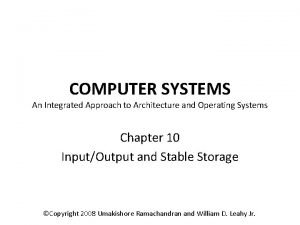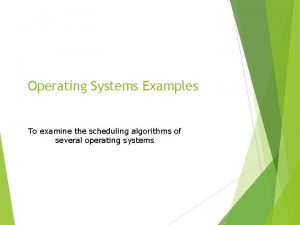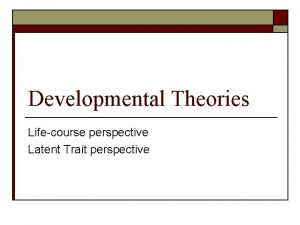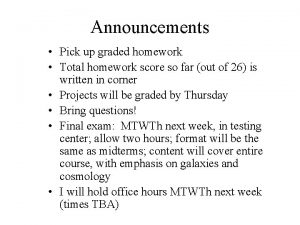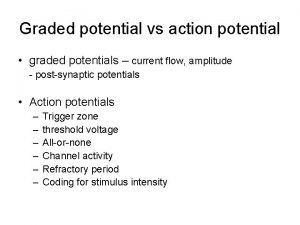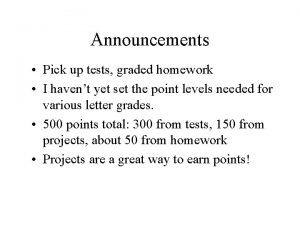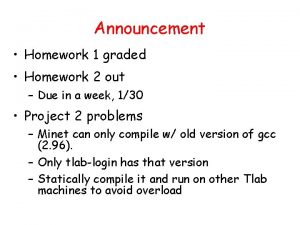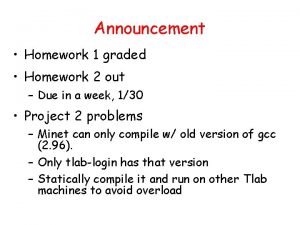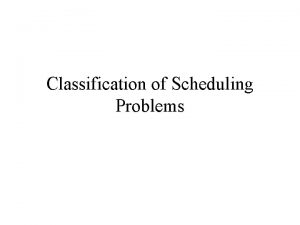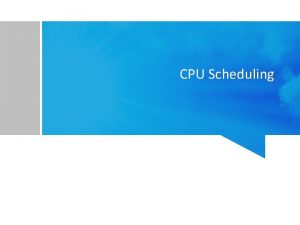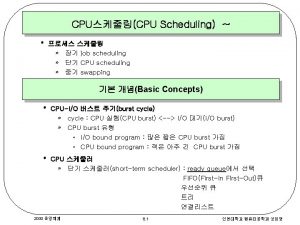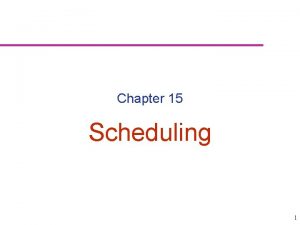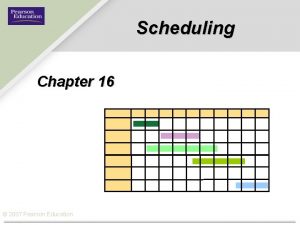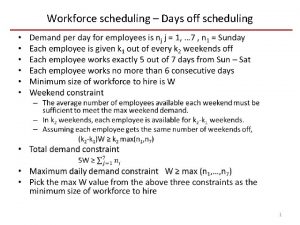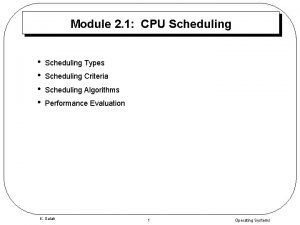Scheduling Algorithms Announcements Homework 1 is graded Homework























- Slides: 23

Scheduling Algorithms

Announcements • Homework 1 is graded • Homework 2 is on CMS • Prelim is in class on 14 th March

Scheduling Algorithms FCFS • First-come First-served (FCFS) (FIFO) – Jobs are scheduled in order of arrival – Non-preemptive • Problem: – Average waiting time depends on arrival order P 1 P 2 0 16 P 2 0 P 3 4 P 3 time 20 24 P 1 8 • Advantage: really simple! 24

Convoy Effect • A CPU bound job will hold CPU until done, – or it causes an I/O burst • rare occurrence, since thread is CPU-bound long periods where no I/O requests issued, and CPU held – Result: poor I/O device utilization • Example: one CPU bound job, many I/O bound • • • CPU bound runs (I/O devices idle) CPU bound blocks I/O bound job(s) run, quickly block on I/O CPU bound runs again I/O completes CPU bound still runs while I/O devices idle (continues…) – Simple hack: run process whose I/O completed? • What is a potential problem?

Scheduling Algorithms LIFO • Last-In First-out (LIFO) – Newly arrived jobs are placed at head of ready queue – Improves response time for newly created threads • Problem: – May lead to starvation – early processes may never get CPU

Problem • You work as a short-order cook – Customers come in and specify which dish they want – Each dish takes a different amount of time to prepare • Your goal: – minimize average time the customers wait for their food • What strategy would you use ? – Note: most restaurants use FCFS.

Scheduling Algorithms: SJF • Shortest Job First (SJF) – Choose the job with the shortest next CPU burst – Provably optimal for minimizing average waiting time P 1 P 3 0 15 PP 2 2 PP 3 3 0 3 • Problem: P 2 21 24 P 1 9 24 – Impossible to know the length of the next CPU burst

Scheduling Algorithms SRTF • SJF can be either preemptive or non-preemptive – New, short job arrives; current process has long time to execute • Preemptive SJF is called shortest remaining time first P 2 P 3 0 P 1 6 21 10 P 2 10 13 P 1 24

Shortest Job First Prediction • Approximate next CPU-burst duration – from the durations of the previous bursts • The past can be a good predictor of the future • No need to remember entire past history • Use exponential average: tn duration of the nth CPU burst n+1 predicted duration of the (n+1)st CPU burst n+1 = tn + (1 - ) n where 0 1 determines the weight placed on past behavior

Priority Scheduling • Priority Scheduling – Choose next job based on priority – For SJF, priority = expected CPU burst – Can be either preemptive or non-preemptive • Problem: – Starvation: jobs can wait indefinitely • Solution to starvation – Age processes: increase priority as a function of waiting time

Round Robin • Round Robin (RR) – – – Often used for timesharing Ready queue is treated as a circular queue (FIFO) Each process is given a time slice called a quantum It is run for the quantum or until it blocks RR allocates the CPU uniformly (fairly) across participants. If average queue length is n, each participant gets 1/n

RR with Time Quantum = 20 Process Burst Time P 1 53 P 2 17 P 3 68 P 4 24 • The Gantt chart is: P 1 0 P 2 20 P 3 37 P 4 57 P 1 77 P 3 P 4 P 1 P 3 97 117 121 134 154 162 • Higher average turnaround than SJF, • But better response time

Turnaround Time w/ Time Quanta

RR: Choice of Time Quantum • Performance depends on length of the timeslice – Context switching isn’t a free operation. – If timeslice time is set too high • attempting to amortize context switch cost, you get FCFS. • i. e. processes will finish or block before their slice is up anyway – If it’s set too low • you’re spending all of your time context switching between threads. – Timeslice frequently set to ~100 milliseconds – Context switches typically cost < 1 millisecond Moral: Context switch is usually negligible (< 1% per timeslice) unless you context switch too frequently and lose all productivity

Scheduling Algorithms • Multi-level Queue Scheduling • Implement multiple ready queues based on job “type” – – – interactive processes CPU-bound processes batch jobs system processes student programs • Different queues may be scheduled using different algos • Intra-queue CPU allocation is either strict or proportional • Problem: Classifying jobs into queues is difficult – A process may have CPU-bound phases as well as interactive ones

Multilevel Queue Scheduling Highest priority System Processes Interactive Processes Batch Processes Student Processes Lowest priority

Scheduling Algorithms • Multi-level Feedback Queues • Implement multiple ready queues – Different queues may be scheduled using different algorithms – Just like multilevel queue scheduling, but assignments are not static • Jobs move from queue to queue based on feedback – Feedback = The behavior of the job, • e. g. does it require the full quantum for computation, or • does it perform frequent I/O ? • Very general algorithm • Need to select parameters for: – Number of queues – Scheduling algorithm within each queue – When to upgrade and downgrade a job

Multilevel Feedback Queues Highest priority Quantum = 2 Quantum = 4 Quantum = 8 FCFS Lowest priority

A Multi-level System high I/O bound jobs priority CPU bound jobs low timeslice high

Thread Scheduling Since all threads share code & data segments • Option 1: Ignore this fact • Option 2: Gang scheduling – run all threads belonging to a process together (multiprocessor only) – if a thread needs to synchronize with another thread • the other one is available and active • Option 3: Two-level scheduling: – Medium level scheduler – schedule processes, and within each process, schedule threads – reduce context switching overhead and improve cache hit ratio • Option 4: Space-based affinity: – assign threads to processors (multiprocessor only) – improve cache hit ratio, but can bite under low-load condition

Real-time Scheduling • Real-time processes have timing constraints – Expressed as deadlines or rate requirements • Common RT scheduling policies – Rate monotonic • Just one scalar priority related to the periodicity of the job • Priority = 1/rate • Static – Earliest deadline first (EDF) • Dynamic but more complex • Priority = deadline • Both require admission control to provide guarantees

Postscript • The best schemes are adaptive. • To do absolutely best we’d have to predict the future. – Most current algorithms give highest priority to those that need the least! • Scheduling become increasingly ad hoc over the years. – 1960 s papers very math heavy, now mostly “tweak and see”

Problem • What are metrics that schedulers should optimize for ? – There are many, the right choice depends on the context • Suppose: – You own an airline, have one expensive plane, and passengers waiting all around the globe – You own a sweatshop, and need to evaluate workers – You are at a restaurant, and are waiting for food – You are an efficiency expert, and are evaluating government procedures at the DMV – You are trying to find a project partner or a co-author – You own a software company that would like to deliver a product by a deadline
 Disk scheduling algorithms
Disk scheduling algorithms Scheduling algorithms examples
Scheduling algorithms examples Sjn scheduling
Sjn scheduling Potentiial
Potentiial /r/announcements
/r/announcements General announcements
General announcements David ritthaler
David ritthaler Burning bright fahrenheit 451
Burning bright fahrenheit 451 Pvu announcement today
Pvu announcement today Grant always turns in his homework
Grant always turns in his homework Jack prelutsky homework oh homework
Jack prelutsky homework oh homework Homework oh homework poem
Homework oh homework poem Homework oh homework
Homework oh homework Alitteration definition
Alitteration definition Homework oh homework i hate you you stink
Homework oh homework i hate you you stink Bioecological approach
Bioecological approach Early help assessment derbyshire
Early help assessment derbyshire Graded vs action potential
Graded vs action potential Graded care profile template
Graded care profile template Age graded theory
Age graded theory Decremental graded potential
Decremental graded potential Diff between step index and graded index fiber
Diff between step index and graded index fiber Graded approach meaning
Graded approach meaning Pharmacodynamics
Pharmacodynamics
